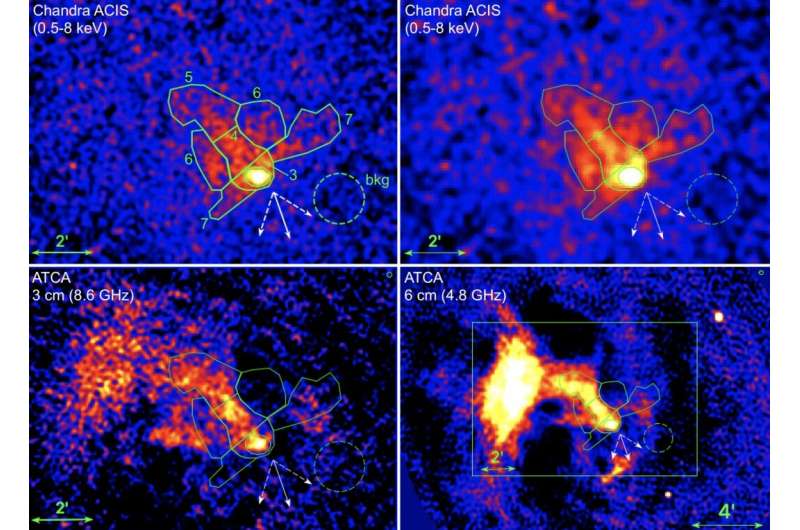Top: Merged Chandra X-ray images of the J1016 PWN (with point sources removed). Bottom: ATCA radio images of the J1016 PWN and surrounding field. Credit: Klingler et al., 2022.
Using NASA's Chandra X-ray observatory and Australia Telescope Compact Array (ATCA), astronomers have investigated a pulsar wind nebula, dubbed "the Goose," powered by a young pulsar known as PSR J1016–5857. Results of the study, published April 27 on the arXiv pre-print server, deliver important insights into the nature of this nebula.
Pulsar wind nebulae (PWNe) are nebulae powered by the wind of a pulsar. Pulsar wind is composed of charged particles; when it collides with the pulsar's surroundings, in particular with the slowly expanding supernova ejecta, it develops a PWN.
Particles in PWNe lose their energy to radiation and become less energetic with distance from the central pulsar. Multiwavelength studies of these objects, including X-ray observations, especially using spatially-integrated spectra in the X-ray band, have the potential of uncovering important information about particle flow in these nebulae. This could unveil important insights into the nature of PWNe in general.
At a distance of some 11,500 light years, PSR J1016–5857 (or J1016) is a young and energetic pulsar with a spin period of approximately 107 milliseconds. The pulsar's characteristic age is estimated to be 21,000 years, while its spin-down power was measured to be about 2.6 undecillion erg/s.
Observations of J1016 have revealed the presence of a PWN with a peculiar shape somewhat resembling that of a goose in flight. Radio images show that the pulsar is located at the "head" of this "Goose PWN," and with a noticeable bend in the "neck." In order to shed more light on the properties of this peculiar PWN, a group of astronomers led by Noel Klingler of NASA's Goddard Space Flight Center decided to examine this object with Chandra and ACTA.
The X-ray spectroscopic observations of J1016's tail and its surroundings revealed the presence of thermally-emitting plasma in the pulsar field. This finding, together with the existence of nearby radio structures, suggests that J1016 is still inside its progenitor supernova remnant (SNR). However, the boundaries of this SNR are still not fully constrained.
The study found that the proper motion of J1016 is 28.8 mas per year (at a position angle 198 degrees East of North), which corresponds to projected velocity at a level of 440 km/s. In general, the images show that the direction of proper motion is in agreement with the shape of the PWN and the direction of the tail.
Furthermore, the researchers found that at larger distances, the tail of J1016 fades in X-rays, but the radio emission becomes brighter. Finally, this tail abruptly bends and appears to connect with a larger radio structure (possibly the Goose PWN). The authors of the paper suppose that this is due to an interaction with the reverse shock inside the PWN's host supernova remnant.
It was also found that the PWN spectrum softens with increasing distance from the pulsar. The astronomers concluded that such behavior may be caused by the rapid synchrotron burn-off.
More information: Noel Klingler et al, "The Goose" Pulsar Wind Nebula of PSR J1016–5857: The Birth of a Plerion. arXiv:2204.13167v1 [astro-ph.HE], arxiv.org/abs/2204.13167
© 2022 Science X Network
























